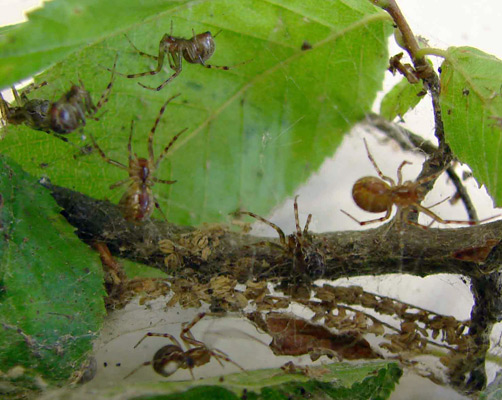(单词翻译:单击)
听力文本
This is Scientific American — 60-Second Science. I'm Jason G. Goldman.
What has eight legs, eight eyes, and lives together with thousands of others like it? Arachnophobia sufferers do not want to hear the answer—which is, spiders that live in large social groups.
It's pretty rare to find such group-living spiders. Of the 45,000 spider species we know about, only about 25 are social. These species weave massive webs and dwell in colonies of dozens, hundreds or even thousands of individual spiders.
"When we want to count the spiders inside the colony, what we do is, somebody rips apart the colony, basically, with their hands. And then, we call it 'making it rain,' and then dozens or hundreds of spiders basically shower down on little silken lines like little parachuters." University of California Santa Barbara arachnologist Jonathan Pruitt.
He and his students study social spiders in South Africa's Kalahari Desert. After counting and weighing hundreds of African social spiders, Pruitt and his team gave each spider a personality assessment—some are bold, others shy. They wanted to understand how the personality composition of a colony influences its interactions with predators, and how the colony behaved over time.

So the researchers combined their spiders into artificial groupings. Some of the experimental colonies were composed only of bold spiders, others of shy ones, and some had the two personality types in equal proportion. Then the researchers introduced predators to the party.
"The most voracious predator that they deal with is this pugnacious ant, Anoplolepis steingroveri, which is this horrible ant. If you dropped one of these social spiders onto the ground, it's identified in seconds. And so these ants rip it apart and then drag it over to their colony."
Turned out that the mixed-personality colonies were best able to learn from the repeated threat of ant raids, and build defensive nests to ward off attackers. Both the all-bold and all-shy colonies were less able to get it together enough to create their defensive structures, presumably because of too many—or not enough—leaders. The results are in the journal Animal Behaviour.
"The cool thing about social spiders is we know that they have these personality differences, and we know that societies are organized along these individual differences in behavior—actually very similar to the way that human societies are organized in a lot of ways."
Thanks for listening Scientific American — 60-Second Science Science. I'm Jason G. Goldman.
参考译文
这里是科学美国人——60秒科学。我是杰森·古尔德曼。
哪种生物有八条腿、八只眼,而且和其他数百只类似生物生活在一起?蜘蛛恐惧症患者可能并不想听到这个答案,答案就是在大型群居团体中生活的蜘蛛。
这种群居蜘蛛非常罕见。在目前我们已知的4.5万种蜘蛛物种中,只有25种蜘蛛是群居生活。这些蜘蛛物种会编织巨大的网,供数十只、数百只甚至数千只蜘蛛居住。
“如果我们想计算群居地内的蜘蛛数量,我们就要让人用手撕破它们的群居地。我们称之为‘下雨’,然后数十只或数百只蜘蛛会像跳伞者一样掉到像丝绸一样的线上。”加州大学圣塔芭芭拉分校的蜘蛛学家乔纳森·普鲁伊特说道。
他和他的学生们对南非卡拉哈里沙漠的群居蜘蛛进行了研究。在对数百只非洲群居蜘蛛计数及称量之后,普鲁伊特和他的团队对每只蜘蛛进行了个性鉴定,有些蜘蛛大胆自信,其它则比较害羞。他们想了解群体里的个性成分对其与捕食者的交互有何影响,以及随着时间的推移,这个群体会如何表现。
所以研究人员将这些蜘蛛进行了人工分组。一些实验群体里只有大胆的蜘蛛,另一些群体只有害羞的蜘蛛,其它群体则由两种个性的蜘蛛按相同比例组成。然后研究人员把捕食者引进各群体中。
“它们需要应对的最贪婪的捕食者是这只好斗的蚂蚁,捷蚁,就是这只可怕的蚂蚁。如果你将其中一只群居蜘蛛放到地上,数秒之内它就会被识别,然后这些蚂蚁就会将它撕碎,拖到它们的群居地。”
结果证明,拥有混合个性的群体最有能力从蚂蚁重复不断的袭击威胁中吸取教训,并建立抵御攻击者的防御巢。大胆的蜘蛛群体与害羞的蜘蛛群体都不太善于建造自己的防御结构,可能是因为它们要么领导者太多要么没有足够的领导者。这一研究结果发表在《动物行为》杂志上。
“群居蜘蛛有趣的地方在于我们知道它们在个性方面存在差异,我们知道蜘蛛根据行为上的个体差异组建群体,这其实在很多方面都非常类似于人类社会的组建方式。”
谢谢大家收听科学美国人——60秒科学。我是杰森·古尔德曼。
译文为可可英语翻译,未经授权请勿转载!
重点讲解
重点讲解:
1. be composed of 组成;构成;
例句:The class is composed of twelve boys and eight girls.
这个班由十二个男孩和八个女孩组成。
2. deal with 处理;应付;与…打交道;
例句:They were not equipped to deal with the situation.
他们没有准备好应付这种局面。
3. turn out 原来是;结果发现;
例句:It turned out that my surmise was correct.
结果表明我的推测没有错。
4. learn from (从…中)吸取(教训);
例句:You must try to learn from your mistakes.
你得从所犯错误中吸取教训。
5. ward off 避开,躲开,防止(危险、疾病等);
例句:She may have put up a fight to try to ward off her assailant.
她可能进行了顽强的反抗,试图击退袭击者。


